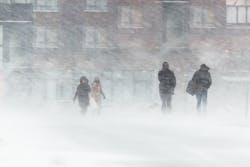With luck it won’t be an extremely cold winter. If it is, large portions of North America’s grid may not be up to the task, according to a new report by the chief agency that monitors electric reliability.
No singular problem besieges the North American grid; there are several that could lead to power shortfalls, according to 2022-2023 Winter Reliability Assessment produced by the North American Electric Reliability Corporation (NERC).
Demand for power is rising during peak periods. Power plants are inadequately weatherized. Fuel supply is at risk and certain regions lack natural gas infrastructure.
Microgrids keep the power flowing during grid outages to those facilities that have them. But their numbers are still few, although development is accelerating, particularly in states like California where power outages are more frequent.
Lack of fuel for power generators
“Fuel supply issues appear prominently in this year’s assessment. Reliability coordinators across North America are closely monitoring the coal and liquid fuel inventories, as well as the potential impacts that transportation disruptions can have on availability and replenishment of all fuels,” said John Moura, NERC’s director of Reliability Assessment and Performance Analysis. “Also, while the grid has a sufficient supply of capacity resources under normal winter conditions, we are concerned that some areas are highly vulnerable to extreme and prolonged cold. As a result, load-shedding may be required to maintain reliability.”
Load shedding — the shutting off of power delivery to certain electric customers — keeps the supply/demand equilibrium on the grid from going out of balance, a situation that can cause uncontrolled power outages.
New England’s LNG problem
New England could run up short on fuel supply to operate power plants during extreme and prolonged cold, according to the report. Demand is high on the global market in part because Europeans are vying for the resource as an alternative to energy from Russia.
New England uses LNG to alleviate its natural gas pipeline constraints.
LNG is vaporized and injected into pipelines that can power multiple natural-gas-fired power plants. The region also comes into winter with “lagging” oil inventory, far lower than last winter, and “close to being insufficient for the kind of extreme winter events that could occur in the area,” NERC said.
Texas: Improvements made but risk persistsIn Texas and nearby states there is risk of a “significant number” of power plants going off line in “extreme and prolonged cold temperatures,” according to the NERC report. This is what happened during Winter Storm Uri in February 2021 when millions of Texans lost power and heat. Demand for power rises during the cold weather further exasperating any energy shorts
The good news is that the Texas power plant owners have made progress improving generators since Winter Storm Uri in 2021, according to NERC.
Middle states not keeping upThe grid is also at risk in the middle states, territory of grid operator MISO, because nuclear and coal fired plants that provided 4.2 GW were retired last year and have yet to be replaced.
“An extreme cold-weather event that extends deep into MISO’s area could lead to high generator outages from inadequate weatherization in southern units and unavailability of fuel for natural-gas-fired generators,” the report said.
Demand for power growing in Canada
In Canada, NERC sees potential grid problems in areas of Alberta, the Maritimes, Ontario and Québec because of growing winter peak electricity demand.
“Alberta has sufficient capacity for normal winter peak demand; however, extreme conditions that cause high generator forced outages are likely to cause energy emergencies,” the report said.
“While the risk of energy emergencies in the three areas hardest hit during that event has not been eliminated, enhancements to equipment freeze protection and cold weather preparations for both the gas and electric industries is a positive step,”
Said Mark Olson, NERC’s manager of reliability assessments said NERC called for power plants operators to undertake a series of actions to prepare for the potential shortfalls.
For information about microgrids and extreme weather, see:
About the Author
Elisa Wood
Editor-in-Chief
Elisa Wood is the editor and founder of EnergyChangemakers.com. She is co-founder and former editor of Microgrid Knowledge.
